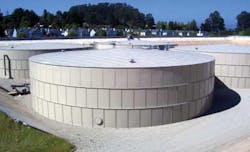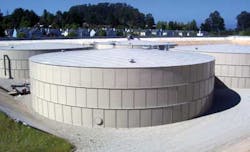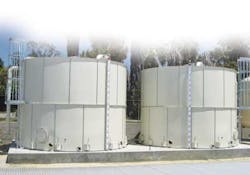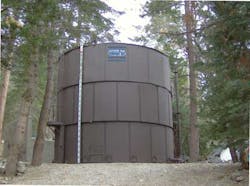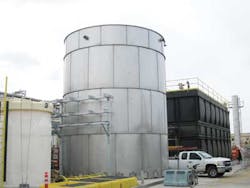Tank Goodness: Is a 'Tank in a Box' right for your next project?
By Brandon Alexander
Bolted steel water storage tanks are nothing new and have been used for decades with great levels of success. These tanks are sometimes referred to as a "Tank in a Box" due to the modular design of bolted steel tanks, which allows them to be packed and easily shipped anywhere in the world. Commonly, tanks are shipped via truck or standard shipping container. Tank kits come complete with hardware and fittings, and are ready to erect upon arrival. When properly designed, manufactured and installed, a "Tank in a Box" meets a wide variety of applications.
The unique modular "Tank in a Box" design is based on the use of individual heavy gauge steel plates, which are used to form the tanks. These plates are prefabricated in dedicated facilities using a variety of specialized equipment such as press breaks, robotic welding arms, drill presses and coating machinery. The final finish is applied to all tank components before they are packed for shipping. The components are precision-manufactured for longevity and a well-crafted bolted steel tank can provide over 60 years of service.
Once on site the tanks quickly bolt together with minimum site work. The erection time of a bolted tank can be as little as 1/3 of the time required to construct a similar size welded tank. In addition, the plates arrive to the job site complete with final finish already applied, eliminating the need to sandblast and paint on site. As the tanks only need to be assembled, they can be erected in various weather conditions and are resistant to adverse weather delays.
The tank kits can be delivered to a wide variety of locations and are well suited to spaces with limited access, high fire danger areas and remote locations. The tanks are comprised of a number of smaller plates, therefore avoiding the need for a large staging area. Bolted tanks can be installed quickly within a tight infrastructure or even inside an existing building. To reach remote sites the individual panels can be transported by smaller trucks. In addition, welding and other "hot work" common with welded tanks is eliminated, increasing safety around flammable materials.
The application also makes an impact on the decision to source a bolted steel tank. Bolted steel tanks are well suited for a variety of water applications. The most common is potable water storage for water municipalities or rural water districts. Use of bolted steel tanks is increasing at wastewater facilities, as well, to store recovered wastewater or stormwater for treatment and reuse. Bolted steel tanks are also common in fire protection systems found in large facilities or in remote wilderness areas.
Although bolted steel tanks are delivered in a box, they are available in a large variety of sizes and are custom-engineered to the specific application and location. Bolted steel tanks are cost effective in the capacity range of 10,000 to 2,000,000 gallons. By increasing or decreasing the number of rings or the number of plates per ring, the height and diameter can be changed. The height-diameter ratio should be evaluated to ensure the tank meets the conditions of the site. The tank manufacturer will engineer and fabricate the tank to meet local building codes as well as snow, seismic and wind loads for the site. Because bolted steel tanks are modular and use interchangeable plates, they can be easily expanded by adding rings of plates if the original design allowed for future growth. It is important to work with an experienced tank engineer who will guide customers through this complex process.
Bolted steel tank kits include all the proper fittings, piping and ventilation components required for the project. The customized fittings and accessories are specific to the application and will facilitate future sampling, inspection and maintenance. If needed, active or passive mixing systems can be included in the tank package from the factory. These systems reduce thermal stratification and help to better circulate disinfectant, thereby reducing overall disinfectant usage.
Since bolted steel tanks are manufactured off site, they are available with a variety of finishes including standard powder coating, premium powder coating and hot dipped galvanizing. Stainless steel tanks are also available. Each finish is best suited for a particular application and the finish coating will impact the longevity and long-term performance of the tank. With proper application and proper maintenance, the right finish will provide over 60 years of service.
Finishing Up
Of the various factory-applied finishes, powder coating is the most common and its use is well established. The powder is applied at the manufacturing plant in an environmentally controlled spray booth, and then baked at moderate temperatures to thermoset the coating. High temperatures above 1000˚F are avoided to prevent panel warping. As the powder is electrostatically applied in dry form, the process provides 100% coverage without voids, drips or runs common with liquids.
Different powder formulas are used to provide the maximum amount of durability depending on storage application (interior, exterior, brine, wastewater, potable, etc.). Standard and premium versions of powder coating are available based on the project requirements. Powder coating is non-porous and designed to meet AWWA, NSF and FDA standards, and various colors are offered to meet customer requirements. Some manufacturers add a liquid seal under the powder coating as additional corrosion protection. If damage to the coating should occur, repair is typically very simple as most damage does not penetrate to the steel. Most repairs can be made by field personnel using commonly available materials.
Another well established and extremely durable coating is hot dipped galvanizing. During this process, the individual plates are immersed in hot liquid zinc, which completely covers the surface. The zinc metallurgically bonds with the iron in the steel to form several iron/zinc alloy layers. The top layer of pure zinc is very durable and corrosion resistant. Only select tank manufacturers can provide NSF approved galvanized tanks for potable water storage as NSF prescribes strict guidelines for the galvanization process. In addition, not all local governing agencies allow galvanized storage tanks for potable water and your tank engineer can assist with this determination.
Another option for food processing or highly corrosive environments is stainless steel. Stainless steel is a special steel alloy which provides superior corrosion resistance. Entire tank plates are crafted from stainless steel then polished and processed to a high gloss. Modular bolted steel tanks are a great option as the individual plates are very easy to fabricate using stainless steel. Select bolted steel tank manufacturers with the skill to work with stainless steel offer this as an option for specific applications.
Because the finish is applied in the factory, it is important to research the tank manufacturer to ensure they have an established history and the skill to work with a particular type of coating. When preformed properly, the pre-applied finish will provide years of trouble-free service.
Although the only work required on site is the assembly and erection of the bolted steel tank, select manufacturers also offer complete project fulfillment. These companies can engineer, manufacture and install bolted steel tanks, making the process simple and smooth. Finding an experienced company that specializes in bolted steel tanks with internal engineering, manufacturing and installation capabilities will significantly facilitate the project.
It is important to take a comprehensive approach when purchasing a bolted steel tank as there are many variables and several manufacturers to consider. Remember that the initial cost may not provide the lowest life cycle cost when all other factors are considered. Select tank manufacturers will work directly with customers to design and manufacture a bolted steel tank specific to the project requirements.
When properly engineered and purchased from an established manufacturer, a "Tank in a Box" will provide the perfect solution for a wide variety of storage needs, combining fast construction, low maintenance costs and a long lifespan.
About the Author: Brandon Alexander currently serves as Marketing Coordinator for Superior Tank Co. Inc., located in Southern California. Mr. Alexander has worked in heavy manufacturing and construction since 2000 with projects ranging up to $20,000,000. Superior Tank Co. manufacturers and erects bolted steel tanks throughout the United States, Mexico and Canada. STCI tank kits have also been shipped to countries throughout the world.
